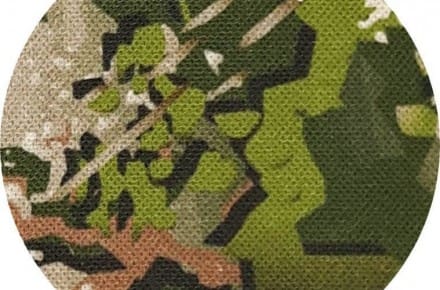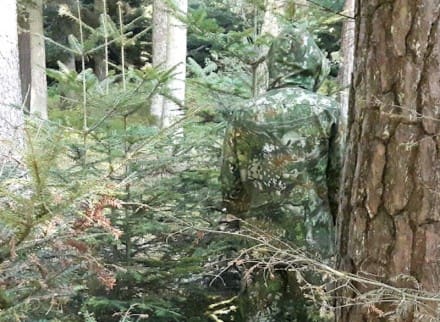Shortly before the IWA we are pleased to present the new CONCAMO. It comes from Germany and was developed by Matthias Bürgin. And it will land from now on: Leo Köhler produces clothing from this new camouflage print. Gear in CONCAMO will come from ZENTAURON.
As you can see, you hardly see anything. But someone is hiding in the middle.
The story behind Confusion Camoflage (CONCAMO): The developer of CONCAMO designed camouflage even as a 10 year old child. The basic idea for CONCAMO was born in 1992 when Matthias Bürgin designed the first three dimensional camouflage nets at the age of 17. During his service with a special military unit, he was able to deepen his knowledge about camouflage patterns and their effects. After his active service, he turned it into a hobby and continued to design patterns for a variety of purposes, from the urban to the high mountain pattern. The breakthrough came after he became familiar with perceptual psychology. CONCAMO effectively confuses the subconscious with a special patented pattern arrangement.
Now is the time to release CONCAMO into the wild. At the IWA 2018 trade fair, the camouflage pattern CONCAMO green will be presented at Leo Köhler’s booth and starting May 2018, CONCAMO green will be on sale.
Here is a comparison with common patterns. We will definitely take a closer look at the camouflage pattern at the IWA 2018 in Nuremberg. More infos and high resolution pictures can be found on the homepage of CONCAMO.
CONCAMO: http://concamo.com
Leo Köhler: www.leokoehler.com
CONCAMO can be seen at Leo Köhler on IWA 2018 Halle 9, booth 9-343.






Looks like a quality pattern. I’m curious to see if this gets any traction with any of the European forces, or it stays on the public market clothing racks.
There are some good options out there, and the photo comps they have also show how well Multicam works in some regions.
This one awfully reminds me the hunting patterns, which is not bad but not quite suitable for all terrain and various season, as soldiers travel around the world. The sample photos are too limited in one space, need more pictures to judge, but it seems not a bad pattern. Although it would be very awkward to see that pattern standing in more tanned and dry area.
I would like to see Kryptek next to it, I feel like this is the closest to that pattern
The problem with all these patterns built up of these tiny little elements that are almost photo-realistic is that once they encounter the real world in the form of dirt…? Their superiority over something like OD green evaporates in direct proportion to how much dirt there is obscuring the pattern.
Patterns built out of larger elements actually seem to get better when dirty, as in the Swedish M90. Throw some mud on that stuff at random, and instead of it blocking out the pattern’s effectiveness, it seems to improve it.
I’ve often wondered why the hell we don’t test these patterns in at least two modes–Spanking-new and clean, vs. “been there, done that, have the dirt to show for it…”. Hell, they probably ought to be testing them in “factory new” and “been issued and worn for a year” modes, as well. We’re all familiar with the “cook whites” phenomenon, as well as how the old BDU Woodland pattern could shift its color palette as it wore.
Unfortunately, I don’t think anyone here in the US has the perspicacity to actually consider doing that sort of thing, much as we don’t bother to baseline mechanical wear on weapons before deployments, and then examine them again after, to see what is actually getting worn/damaged…
I like the cut of your jib, Kirk.
These things should be validated by standardized testing, and re-evaluated to speed the development cycle.
I’m of the opinion that things military ought to be continuously evaluated and adapted to changing conditions. If the equipment works great in the lab, fine–But, find out how it works in the real world, and then once you’ve ensured it does…? KEEP CHECKING.
Evolutionary beats the revolutionary, every damn time. Almost every time we try for the blue-sky “This will fix everything…” kind of solution, it winds up falling on its face.
You don’t get 100% improvements on performance, in mature technologies. You get itty-bitty incremental improvements, that add up over time. I would love to somehow test out the effect that taking an infantry platoon/company circa 2018 back to the era when we were initially fielding the M16, and then compare the effectiveness and lethality of the unit to one of that era, while comparing the actual effectiveness of the then-intentional SPIW program to what transpired in reality.
My guess is that the 2018 platoon/company would completely outclass the SPIW-equipped unit, and would probably be several times more effective than the then-current unit of the mid-1960s.
And, much of that would be due solely to the evolutionary additions to their equipment, like sights and other such improvements that the SPIW folks never considered.
Makes you wonder–Would we have been better off taking the SPIW funds, and spending them trying to jump-start red dot sights, and something like the ACOG? Not to mention the IR pointers, and all the rest…
IMO south africa had the right idea with dark brown. I think they call it nutria.
People forget how effective solid earth tone colors when properly applied, in comparison to patterns.
It is indeed called Nutria Brown. What I find interesting is that Nutria Brown reminds me a lot of the OD green of the IDF uniforms, which I considered more of a “burnt” OD green. Both of those colors seem to do pretty well over time and both of the countries have shared knowledge in the past it seems as well.
I think the problem is that solid colored uniforms are not as “cool” as all these new, high-speed camouflages.
I wore the OG-107 in the jungle and could blend in just as good as someone in a camouflage uniform.
The best idea I ever heard to clothe a RDF was; “give them the OG-107s and a spray paint can in the dominant color of the AO . . . “